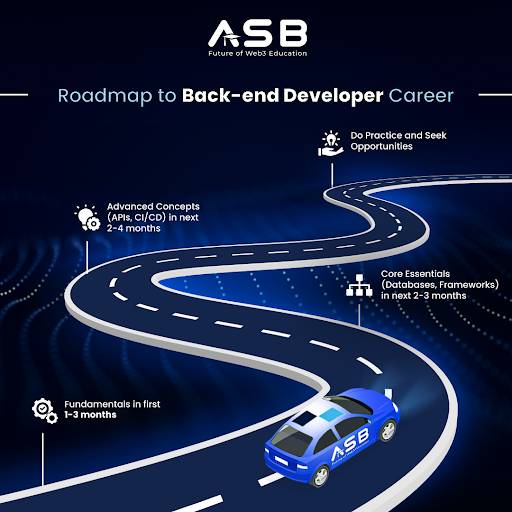Back-end development forms the core of websites and software applications. Be it finance, healthcare, retail, or any other industry, back-end software engineers are required everywhere! Besides, with the rise in e-commerce retail platforms and constant innovations in technologies, these experts are required more than ever.If you want to venture into the field of back-end development, you must get a good grasp of the related technologies and adopt the right way to make a career in the IT sector. So, what does a backend developer do? And how can you start preparing for a successful back-end career?
Here’s a walkthrough of a comprehensive roadmap to making it big in back-end development.
Understanding Back-end Development
The functionalities of any website or application are powered by server-side programming, which is known as backend development. In order to create the logic and infrastructure of a software application, back-end developers utilize various frameworks along with programming languages like PHP, Python, Ruby, or Java. This includes managing user authentication, server configuration, and data storage. Back-end essentially serves as a conduit between the database and the front-end. It also determines a web app’s scalability and ability to function smoothly.
Considering its significance and purpose from a user perspective, it would be right to say that the back-end devs build the pillars of a website/ app.
So, the software developers who work on creating and managing the server-side of websites and applications are back-end specialists/ engineers. To ensure seamlessintegration of the application’s functionality and user interface, they coordinate closely with front-end engineers as well.
Roadmap to a Successful Back-end Developer Career

Generally, it takes 6-10 months to become an expert in back-end development, after which you will be able to perform quite well in the related roles. To become a proficient back-end software engineer, you should focus on the following areas:
1. Brush up on the Fundamentals
The initial 1-3 months should be ideally spent on understanding and revising the fundamentals of web development. This includes the basics of programming, like variables, data types, control flow, functions, etc. Then, you can master a few beginner-friendly languages such as Python and JavaScript. Even though JavaScript is mostly used for front-end development, a survey reported that more than 65% of the developers employ it for back-end work too.
Further, you need to know about version control systems like Git and their role in monitoring code modifications.
2. Master the Core Essentials
In the next 2-3 months, you can gain mastery of the core technologies of back-end development. This mainly comprises databases (MongoDB, MySQL, etc.) and frameworks (Node.JS, Django, etc.). Node.js is the most widely used and popular JavaScript backend framework.
Databases are used to store, manage, manipulate, and retrieve data like user information, transactional records, application settings, and others. On the other hand, frameworks are a set of tools and libraries, that are utilized to implement logic and code, avoid redundancy, and maintain consistency across the website/ application.
The last phase of learning should be dedicated to getting familiar with APIs (Application Programming Interfaces), security practices, performance optimization, cloud computing, and other such concepts. Back-end devs need to be aware of common security threats, caching techniques, automated testing and deployment strategies, and the latest tools to boost scalability.
For a thorough specialization in back-end development, you can opt for an online/classroom program. Leading institutes like ASB (Antier School of Blocktech) offer a three-month certified back-end development course, delivered by industrial experts and top-notch trainers. It also covers hands-on workshops and an actual project to solidify your hold over back-end technologies.
4. Do Practice and Start Networking
Once you have gained complete clarity of the concepts, start practicing and work on real-world projects. You can participate in open-source projects and build some of our own, thus projecting your accomplishments on a well-defined portfolio. A good portfolio is a must to fetch the right internships and job opportunities.
Professional Scope of Back-end Development
Back-end development presents a wide range of career opportunities, spanning different sectors and businesses. Here’s an overview of the popular job profiles for back-end devs:
Back-end Architects: These are in charge of planning and building reliable back-end systems, in alignment with the goals of performance, security, and scalability.
Back-end Software Engineers/ Developers: They are primarily responsible for creating, implementing, and managing the server-side logic of web applications and APIs.
Database Administrators (DBA): These experts are tasked with maintaining and enhancing databases to assure the performance, security, and integrity of data. They create database schemas, handle query performance, and execute backup and recovery plans.
API Developers: They are responsible for creating, conducting, and managing APIs that provide communication between various software programs or systems. They guarantee that APIs are secure, scalable, and well-documented, as per the requirements of the clients.
Other related profiles for back-end devs include that of DevOps engineer, Full-stack developer, Software development engineer in test (SDET), Site reliability engineer (SRE), etc.
Summing-up
With the growing innovations and adoption of technology and its applications, there is an increasing demand for back-end developers. As more and more businesses transition to digital space, the range of jobs for back-end professionals will rise so as to create, manage, and expand the required infrastructure.
However, the competition in the back-end field entails that aspiring professionals stay updated with the upcoming trends and developments in frameworks and programming technologies.
